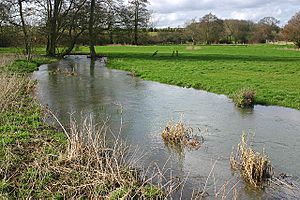River Dorn facts for kids
The River Dorn is a small but important river in Oxfordshire, England. It's like a natural pathway for water, flowing into a bigger river called the River Glyme. This river starts high up in the limestone hills of northern Oxfordshire, not too far from a town called Chipping Norton. From there, it gently winds its way southeast, passing through several villages and beautiful countryside before joining the River Glyme near Wootton.
Contents
Where the River Dorn Begins
The journey of the River Dorn starts about 1.5 miles (2.4 km) east of Chipping Norton. This area is known for its limestone uplands, which are high, hilly areas made of a type of rock called limestone. The water that forms the river comes from these hills, often from springs that bubble up from underground.
The River's Path
As the River Dorn flows, it travels through a variety of landscapes and past several interesting places.
Villages and Gardens
The river first flows past a village called Little Tew. Then, it continues through Sandford St. Martin. Here, the river becomes a special part of the beautiful gardens at Sandford Park, adding to the scenery.
The Bartons and Other Streams
The River Dorn then makes its way through a group of villages known as "the Bartons." These include Westcott Barton, Middle Barton, and Steeple Barton. In Middle Barton, another small stream called Cockley Brook joins the River Dorn, adding more water to its flow.
Joining the River Glyme
Finally, after its journey through the Oxfordshire countryside, the River Dorn meets the River Glyme. This meeting point is just east of the village of Wootton. The River Glyme then continues its own journey, eventually joining the larger River Evenlode.
Why the River Dorn is Special
The River Dorn is more than just a waterway; it's an important part of the local environment. It's recognized as a Site of Special Scientific Interest (SSSI). This means the area around the river is protected because it has special plants, animals, or geological features that are important for science and nature. Protecting rivers like the Dorn helps keep our natural world healthy and diverse for everyone to enjoy.


